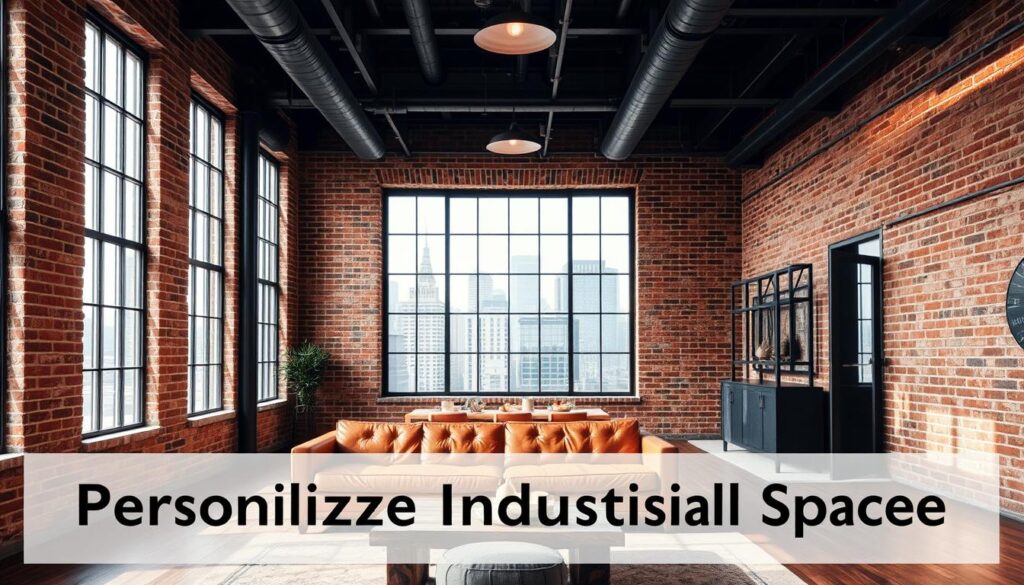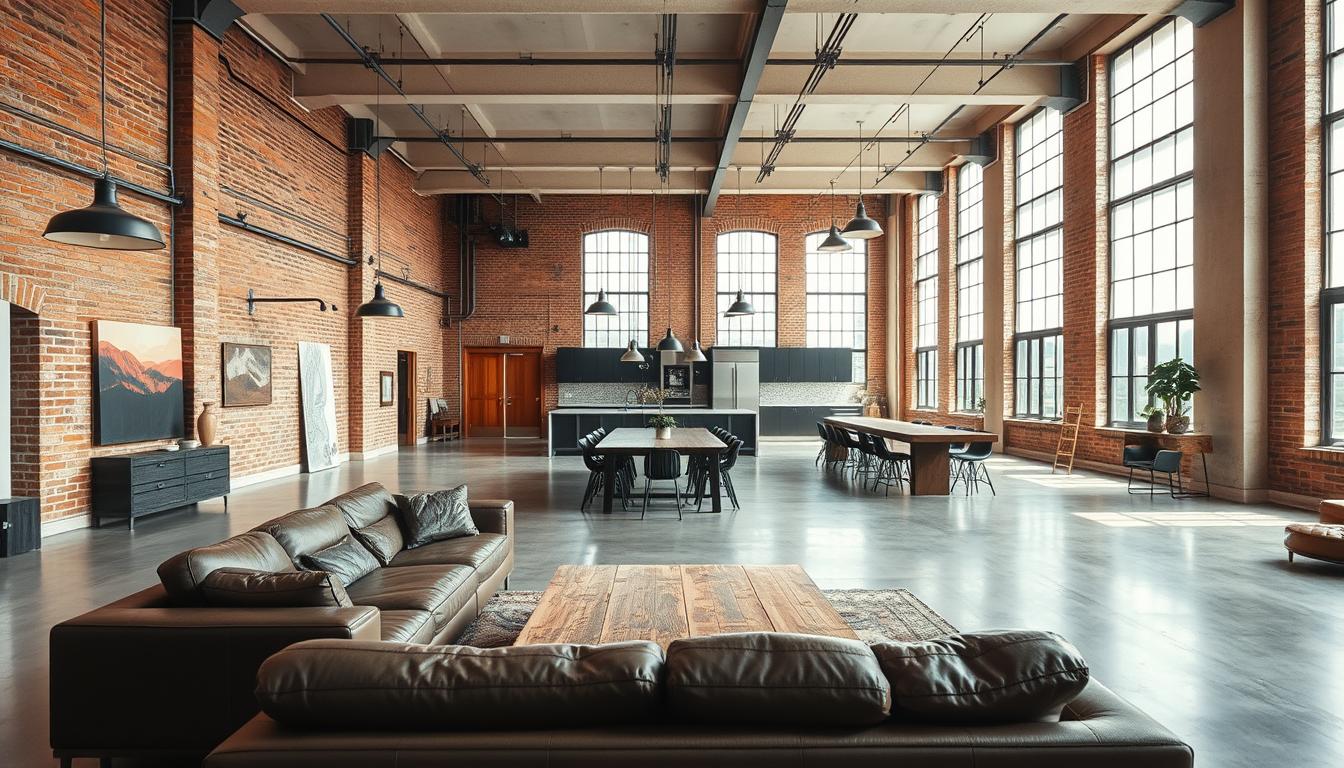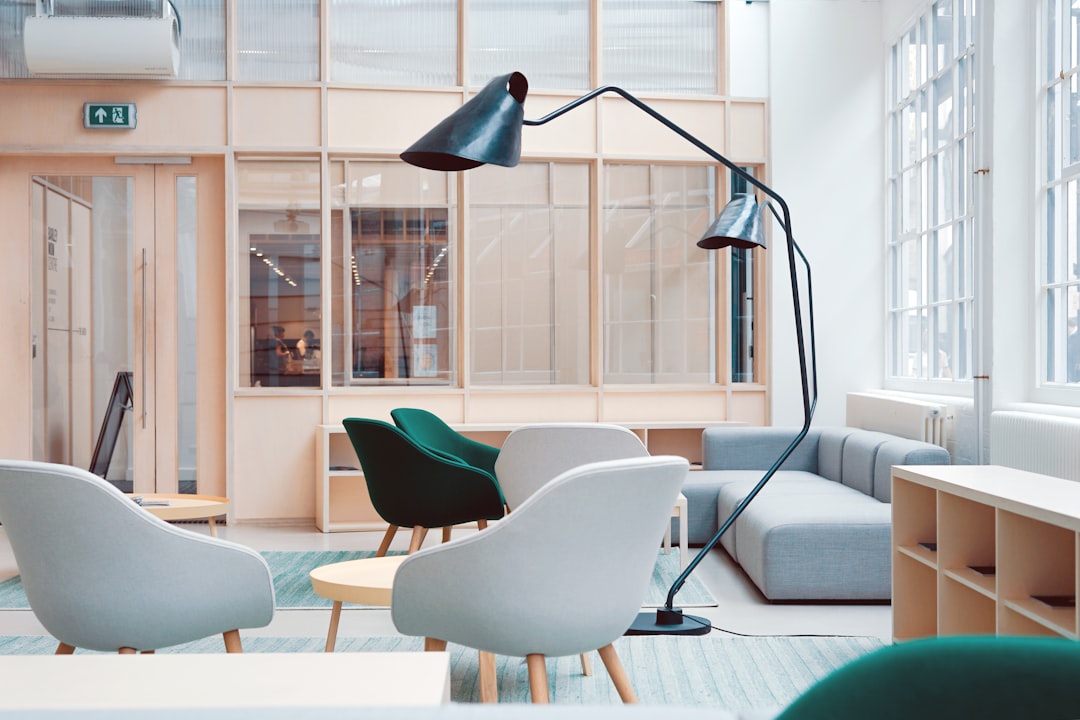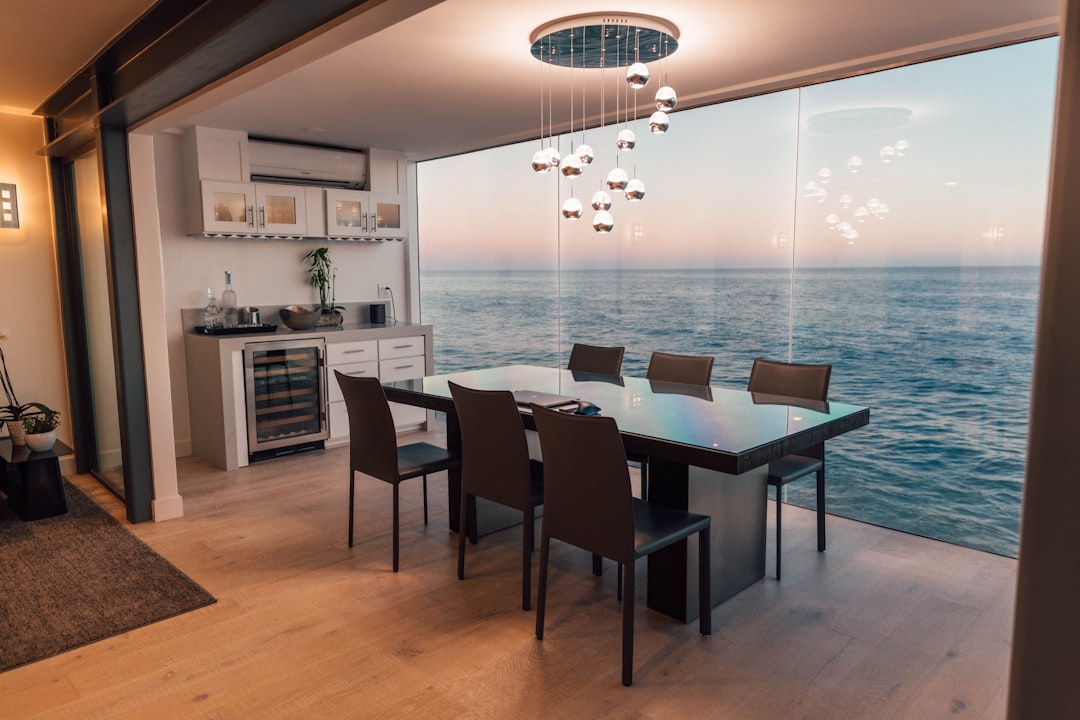Did you know industrial-style interiors are now big in homes and offices? People love them for being open, airy, and still having a rugged feel.
Our team is all about making stunning industrial interiors that look great and work well. We know how to mix industrial design elements into a space that’s both stylish and practical.
Key Takeaways
- Understanding the key characteristics of industrial design.
- The importance of color and lighting in creating a stunning industrial interior.
- Selecting the right furniture and textures to enhance the space.
- Balancing style and functionality in industrial interior design.
- Tips for incorporating industrial elements into your space.
Understanding Industrial Design Elements
Industrial design turns simple spaces into stylish and useful areas. It focuses on raw materials, open spaces, and practical elements.
Key Characteristics of Industrial Interiors
Industrial interiors stand out with exposed brick, metal beams, and reclaimed wood. These features add character and tell the space’s story. Other important traits include:
- Open floor plans for a spacious feel
- High ceilings for an industrial vibe
- Simple designs, focusing on function
Design experts say, “Industrial design is more than looks; it’s about making a space functional and cozy.”
“The beauty of industrial design lies in its honesty – it doesn’t try to hide its origins or pretend to be something it’s not.”
Materials Commonly Used in Industrial Designs
The choice of materials is key in industrial design. Common picks include:
| Material | Characteristics | Use in Industrial Design |
|---|---|---|
| Exposed Brick | Rugged, textured, historical | Accent walls, feature walls |
| Reclaimed Wood | Weathered, sustainable, warm | Flooring, furniture, wall panels |
| Metal | Durable, versatile, industrial | Beams, lighting fixtures, decorative elements |
The Role of Space and Layout
The layout of an industrial space is key to its open feel. Open floor plans are a big part of industrial design. They let areas flow smoothly together. Using partitions or dividers can create zones without losing openness.
Good space planning balances openness with defined areas. This is done by placing furniture and decor thoughtfully.
The Importance of Color in Industrial Spaces
Color is crucial in industrial decor ideas. The right colors can make a space warm and welcoming. The wrong colors can make it cold and unwelcoming.
Color sets the mood in an industrial-style interior. Choosing the right colors makes a space look good and work well.
Popular Color Palettes for Industrial Interiors
Industrial interiors often use neutral tones and bold colors. Neutral colors like gray, beige, and white create a clean look. Bold colors like red, orange, and yellow add excitement.
Some favorite color schemes for industrial interiors include:
- Monochromatic neutrals: Using different shades of one neutral color for a unified look.
- Bold and bright: Adding bold, bright colors for contrast and interest.
- Earth tones: Using brown, green, and tan to warm up an industrial space.
| Color Palette | Description | Example Colors |
|---|---|---|
| Monochromatic Neutrals | Different shades of a single neutral color | Gray, Beige, White |
| Bold and Bright | Bold, bright colors for contrast | Red, Orange, Yellow |
| Earth Tones | Earthy colors for warmth | Brown, Green, Tan |
How Color Affects Mood and Ambiance
Color greatly impacts the mood and feel of an industrial space. Cool colors like blue and green can calm you. Warm colors like orange and red can energize you.
Choosing the right color palette depends on the space’s purpose and the mood you want. For example, a workspace might need energizing colors, while a relaxation area might need calming colors.
Understanding how color affects mood and ambiance helps you pick the right colors for your industrial interior. This ensures your space looks good and works well.
Lighting Strategies for Industrial Interiors
Lighting is key in industrial interiors. It serves both function and beauty. The right lighting can make a space feel cozy or lively, depending on what you want.
Types of Lighting: Ambient vs. Task
In industrial spaces, finding the right mix of ambient and task lighting is crucial. Ambient lighting lights up the whole area, making it bright and welcoming. Task lighting focuses on specific spots, like work areas or reading corners.
For example, in a living room with an industrial vibe, use overhead lights for overall brightness. Add table lamps or under-cabinet lights for task areas. This mix boosts both function and style.
Incorporating Natural Light into Design
Adding natural light to your industrial design makes it even better. Big windows, skylights, and glass doors let in plenty of sunlight. This makes the space feel bigger and more open.
It also cuts down on the need for artificial lights. Plus, it showcases industrial features like brick or concrete, adding to the look.
For more ideas on using natural light and other design elements, check out industrial lounge interior design ideas. They offer lots of inspiration for bright and inviting industrial interiors.
Unique Fixture Ideas for Industrial Spaces
Picking the right lighting fixtures can really make your industrial space stand out. Look for fixtures that match the industrial look, like metal shades or exposed bulbs. Even old industrial equipment can be turned into cool lighting.
As designer Jonathan Adler said, “Lighting is not just about light; it’s about setting a mood.” By choosing fixtures that fit the industrial style, you can make a space that’s both useful and beautiful.
Furniture Selection and Arrangement
Finding the right furniture is key to an industrial-style interior. It must be both stylish and useful. The right furniture can make a space look great and still be practical.
Choosing the Right Industrial-Style Furniture
When picking furniture for an industrial look, choose pieces that show off their raw, useful side. Look for items made from metal, reclaimed wood, and leather. Choose furniture with clean lines and little decoration to keep the industrial feel.
“The beauty of industrial design is in its simplicity and usefulness,” says a top interior designer. “Furniture that is both useful and shows off its materials is essential for a real industrial look.”
Space Utilization and Functionality
Using space well is important in industrial interiors. These spaces often have open layouts and few walls. Choose furniture that does more than one thing or has built-in storage. This makes the space more useful and adds to its industrial charm.
- Multifunctional furniture pieces
- Storage units that double as room dividers
- Modular furniture for flexibility
Mixing Vintage and Modern Pieces
Industrial design is great at mixing old and new. Combining vintage and modern furniture adds depth and character. For example, a vintage metal desk with a modern leather sofa creates a striking contrast. This shows the eclectic spirit of industrial design.
By using these elements, we honor industrial heritage and give our spaces a unique feel. The trick is to balance different styles and eras. Make sure each piece works well with the others.
Adding Textures to Industrial Designs
Texture can make an industrial chic space look and feel better. It adds depth and interest, making the room more lively.
In industrial interiors, texture is key for a cozy yet rugged feel. Mixing different textures creates a balanced and harmonious space.
Incorporating Fabrics and Upholstery
Fabrics and upholstery bring softness and warmth to industrial spaces. Think about using:
- Plush area rugs to define different areas within an open-plan space
- Comfortable, oversized sofas with durable fabric
- Accent pillows in varied textures and patterns to add visual interest
These elements add texture and make the space cozy. They mix industrial chic with comfort perfectly.
The Use of Metal, Wood, and Concrete
Industrial designs often use metal, wood, and concrete. These materials give a rugged, authentic feel.
Metal can be exposed ductwork or metal accents on furniture. Wood adds warmth with wooden beams, furniture, or flooring. Concrete has a raw look, often used for walls, floors, or countertops.
Creating Contrast with Soft Elements
To avoid a space feeling harsh or cold, balance industrial elements with soft textures. This contrast makes the space more inviting.
For example, a metal coffee table with a plush sofa or a soft rug on concrete floors creates a compelling contrast. It enhances the space’s aesthetic.
Open Concept vs. Defined Spaces
Industrial spaces often face a design dilemma: should they adopt an open concept or defined spaces? The choice between these two approaches greatly affects the space’s functionality and look. We’ll look at the benefits of open layouts, discuss how to divide spaces, and find a balance between openness and privacy.
Benefits of Open Layouts
Open layouts are popular in industrial design for good reasons. They offer flexibility since there are no walls to get in the way. This makes it easy to change the layout for different needs and activities.
Open layouts also improve communication and community. Without walls, everyone can see and talk to each other more easily. This creates a sense of togetherness and teamwork.
Enhanced natural light distribution is another big plus. With fewer obstructions, natural light can reach deeper into the space. This reduces the need for artificial lighting and makes the space feel more welcoming. Plus, open layouts can make a space look bigger, which is great for smaller areas.
Partitioning Techniques in Industrial Design
Even with the benefits of open layouts, sometimes defined spaces are needed. Partitioning techniques can create separate areas without losing the openness. Using glass partitions or sliding walls is a good method. They separate zones while keeping visibility and natural light.
Changing flooring materials and layouts can also define areas. For example, different flooring types or patterns can mark a transition from one zone to another. Room dividers or screens can also help create separate spaces in an open layout.
Finding Balance Between Openness and Privacy
Finding the right balance between openness and privacy is key in industrial design. Open layouts encourage teamwork and flexibility but can lack privacy. Designers can add elements for privacy, like private offices or meeting rooms.
Using modular furniture that can be rearranged is a good approach. It can create private areas or define zones in an open space. Adding acoustic panels can also help reduce noise, making the space more private and comfortable. By balancing openness and privacy, industrial spaces can be more functional and welcoming.
Incorporating Technology in Industrial Design
In industrial interior design, technology is key for both looks and function. We aim to make spaces that look good and work well. Adding tech to our designs is crucial.
Smart Home Integration
Technology is being used in smart home integration in industrial design. This means using smart devices to control things like lights, temperature, security, and entertainment. It makes our lives easier and our spaces more efficient.
- Voice Control: Using voice assistants like Alexa or Google Home to control our homes.
- Smart Lighting: Using LED lights that change brightness and color based on the time or activity.
- Automated Systems: Adding systems for heating, cooling, and security to improve comfort and safety.
The Use of Industrial-Style Tech Gadgets
Industrial-style tech gadgets are also being used to enhance industrial interiors. These gadgets look good and serve a purpose, fitting the design theme.
- Industrial-Style Speakers: Speakers that look like industrial equipment, adding to the look while offering great sound.
- Retro-Futuristic Displays: Displays with a retro-futuristic look, mixing old industrial with modern tech.
- Exposed Tech: Showing off technology like wiring or machinery to keep the industrial vibe.
By adding these tech elements, we can make industrial interiors that are both beautiful and practical.
Sustainability in Industrial Interiors
The world of industrial design is moving towards being more eco-friendly. This change is driven by the need for materials and practices that are good for the planet. As we design modern industrial spaces, we must include elements that are both good for the environment and enhance the space’s look and function.
Eco-Friendly Materials and Practices
Using eco-friendly materials is a key part of sustainable industrial design. This means choosing materials that are recycled, recyclable, or sustainably sourced. For example, reclaimed wood adds warmth and character to spaces while saving trees.
Materials like bamboo, low-VOC paints, and recycled metal are also popular for their green benefits. It’s important to use these materials to make our designs more sustainable.
It’s also crucial to adopt eco-friendly practices during construction and upkeep. This includes reducing waste, using energy-efficient lights, and choosing materials with a lower carbon footprint. These steps help lessen the environmental impact of our designs.
Upcycling and Repurposing Furniture
Upcycling and repurposing furniture are creative ways to make industrial decor more sustainable. By breathing new life into old furniture, we reduce waste and add unique charm to spaces. For instance, turning old pallets into shelves or converting vintage machinery into decor pieces adds industrial charm while being eco-friendly.
This approach also boosts creativity and flexibility in design. It encourages us to think creatively and find new uses for items that might end up in landfills. This makes our designs more personal and eco-conscious.
Designing for Longevity
Designing spaces that last is vital in sustainable industrial design. This means creating spaces that are not only beautiful but also durable and adaptable. By focusing on quality over quantity, we reduce waste and save resources.
To achieve this, we should choose materials and furnishings that last, use timeless design, and plan for the future. For example, using durable finishes, investing in quality furniture, and designing flexible layouts help our spaces stay relevant and useful over time.
Personalizing Industrial Spaces
In the world of industrial interiors, making a space your own is key. Even with a minimalist look, you can add personal touches. This makes the space truly unique.

Adding Personal Touches: Art and Decor
Art and decor are great ways to make an industrial space your own. These spaces, with their open layouts, are perfect for showing off your art. Artwork can add warmth and personality to a space that’s mostly industrial.
When picking art and decor, choose pieces that stand out against the industrial look. A vintage rug or modern sculptures can add interest. The goal is to blend the industrial feel with your personal touches.
Balancing Style with Individuality
It’s important to balance industrial style with your own unique touches. Mixing industrial elements with personal items can make a space feel both stylish and personal. Adding vintage or antique pieces can add depth and character.
Texture is also key in making an industrial space inviting. Combining different textures, like metal, brick, and fabric, adds depth and interest.
Personalizing an industrial space is about finding the right mix of style and individuality. By adding your own touches, you can create a space that reflects your personality and feels special.
Case Studies of Successful Industrial Interiors
Exploring industrial interiors, we see a common theme: blending form and function. This design style has become popular for turning raw spaces into beautiful, functional areas.
Residential Industrial Designs
Residential designs with an industrial touch are loved for their charm and practicality. They feature exposed brick, metal beams, and open layouts. For example, a warehouse can turn into a spacious loft, where industrial furniture design is key for both looks and comfort.
In a residential project, designers used reclaimed wood and metal for a unified look. Industrial chic decor like vintage machinery and concrete floors added character.
Commercial Spaces with Industrial Flair
Commercial areas also benefit from industrial design. Restaurants, offices, and stores use industrial elements for a unique vibe. A coffee shop might use exposed ductwork and brick for urban chic. An office might have metal and glass partitions for a modern, industrial feel.
A boutique hotel in an old factory is a great example. It kept the original look while adding modern touches and industrial-style furniture. This made it stylish and practical.
These examples show industrial design’s versatility. It works in homes and commercial spaces, proving its appeal and adaptability.
Future Trends in Industrial Interior Design
Industrial interior design is always evolving. It’s now embracing new trends and materials. Sustainability and creative material uses are becoming key in modern designs.
New Materials on the Horizon
New materials are changing industrial design. Eco-friendly materials, recycled metals, and reclaimed wood are becoming popular. They’re good for the planet and add character to spaces. For more on using industrial design at home, check out Cozy Nest Plans.
Evolving Color Trends
Color trends in industrial design are shifting too. We’re seeing a mix of classic industrial colors and bold, new ones. This mix creates a striking contrast that makes spaces look better and feel more welcoming.



